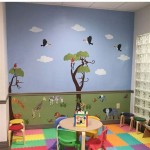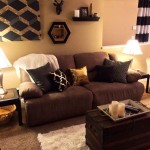Home Decor Color Ideas
Color plays a pivotal role in home decor, shaping the ambiance and influencing the emotions evoked within a space. Choosing the right colors can transform a house into a home, reflecting personal style and creating a harmonious environment. A well-thought-out color scheme can enhance the overall aesthetic appeal, highlight architectural features, and even impact mood and well-being. This article delves into various aspects of home decor color ideas, providing insights and inspiration for creating beautiful and functional living spaces.
Understanding Color Psychology
Color psychology explores the emotional and psychological effects of different hues. Colors can evoke specific feelings and associations, making it crucial to select schemes that resonate with the intended mood and purpose of each room. For instance, calming blues and greens are often used in bedrooms to promote relaxation, while vibrant yellows and oranges can stimulate energy in kitchens or home offices. Consider the following general color associations:
- Red: Energy, passion, excitement
- Orange: Enthusiasm, creativity, warmth
- Yellow: Happiness, optimism, clarity
- Green: Nature, peace, tranquility
- Blue: Calm, serenity, trust
- Purple: Luxury, royalty, spirituality
- White: Purity, simplicity, cleanliness
- Black: Sophistication, power, mystery
While these associations provide general guidance, individual preferences and cultural influences can shape color perceptions. It is essential to experiment with different hues and observe how they make you feel in your own space.
Creating a Color Palette
Building a cohesive color scheme is essential for creating a visually pleasing and harmonious environment. Here are some approaches to developing a color palette for your home:
1. The 60-30-10 Rule
This classic design principle suggests using 60% of the dominant color, 30% of a secondary color, and 10% of an accent color. The dominant color typically sets the overall tone, while the secondary color provides contrast and depth. The accent color adds pops of interest and personality. For instance, a living room could feature a neutral beige as the dominant color, a warm gray as the secondary color, and a vibrant teal as the accent color.
2. Analogous Colors
Analogous colors sit next to each other on the color wheel, creating a harmonious and visually pleasing effect. They often share similar undertones, resulting in a cohesive and balanced scheme. Examples include blue and green, yellow and orange, or red and purple.
3. Complementary Colors
Complementary colors are located opposite each other on the color wheel, creating high contrast and visual excitement. This approach can be bold and dramatic, adding a sense of dynamism to a space. Examples include red and green, blue and orange, or yellow and purple.
4. Monochromatic Palette
A monochromatic palette utilizes different shades, tones, and tints of a single color. This creates a cohesive and sophisticated look, allowing for subtle variations within a unified scheme. For example, a monochromatic palette could feature various shades of blue, from navy to sky blue, or different tones of gray, from charcoal to light gray.
Color Considerations for Different Rooms
Each room in a home serves a different purpose and evokes distinct moods. Here are some color suggestions for various areas:
1. Living Room
Living rooms are often designed for socializing, relaxation, and entertainment. Neutral colors like beige, gray, and white provide a calm and inviting backdrop, while bolder accent colors can add pops of personality. Warm colors like orange or yellow can create a cozy and welcoming atmosphere, while cool colors like blues or greens can promote a sense of tranquility.
2. Bedroom
Bedrooms should be spaces for sleep, relaxation, and rejuvenation. Calming colors like blues, greens, and lavender are often preferred for their calming and restorative properties. Soft whites and creams can also create a serene ambiance, while bolder colors can be used as accent walls or in bedding to add visual interest.
3. Kitchen
Kitchens are often bustling hubs of activity. Neutral colors like white, gray, and cream provide a clean and fresh background, while warmer colors like yellows, oranges, and reds can stimulate appetite and create a welcoming atmosphere. Bold and contrasting colors can be used for accent walls or cabinetry to add a touch of personality.
4. Bathroom
Bathrooms should be relaxing and spa-like spaces. Cool colors like blues, greens, and grays are often used to create a calming and serene ambiance. Warm colors like beige or cream can also work well, creating a sense of warmth and comfort.
Home decor color ideas offer a vast array of possibilities for creating beautiful and functional living spaces. By understanding color psychology, exploring various color schemes, and considering the intended mood and purpose of each room, homeowners can create spaces that reflect their unique personalities and enhance their well-being. Experiment with different colors, observe their impact, and personalize your home to create a sanctuary that inspires and delights.

15 Designer Tricks For Picking A Perfect Color Palette

30 Living Room Color Ideas Best Paint Decor Colors For Rooms

50 Popular Living Room Colors Paint Ideas
:max_bytes(150000):strip_icc()/warm-and-cozy-paint-colors-down-pipe-2f1db86467ff44f9a353672387c8dfba.jpg?strip=all)
15 Paint Colors That Will Make Your Home Feel Warm And Cozy

20 Top Interior Color Schemes For Your House Design Foyr Neo

59 Living Room Color Combinations Best Scheme

100 Best Color Ideas For Every Rooms Decorating With Paint

5 Tips To Help You Choose The Right Colour Scheme Home Decorating Ideas

5 Neutral Living Room Paint Color Ideas Design Cafe

11 Best Chartreuse Color Ideas Home Decorating With







